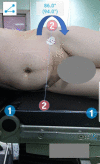Smartphone Application Helps Improve the Accuracy of Cup Placement by Young, Less-Experienced Surgeons during Primary Total Hip Arthroplasty
- PMID: 35514765
- PMCID: PMC9034791
- DOI: 10.22038/ABJS.2021.52402.2587
Smartphone Application Helps Improve the Accuracy of Cup Placement by Young, Less-Experienced Surgeons during Primary Total Hip Arthroplasty
Abstract
Background: Dislocation after total hip arthroplasty (THA) partly under the surgeon's control, by appropriate placement of the components. We aimed in this study to determine the accuracy of using intra-operative smartphone applications (Apps) to place the acetabular cup within the safe abduction angle by less experienced surgeons during THA surgery when compared to the conventional freehand technique for cup placement.
Methods: Sixty primary THAs were performed, 30 using the conventional freehand technique (control group) and 30 using the smartphone app technique (study group) to determine the acetabular cup abduction angle by the same young surgeon with less than one year of experience. Postoperative mean cup abduction angle, mean cup anteversion angle, and the percentage of cups within the safe abduction zone as measured on radiographs were compared between the two groups.
Results: In the study group, the mean cup abduction angle was significantly lower (P=0.0008), and the acetabular cup was placed within the safe zone in a significantly higher (P<0.001) percentage of patients (93% vs 63%) when compared to the control group. However, there was no significant difference (P=0.40) between the two groups when the mean cup anteversion angle was compared.
Conclusion: The smartphone app technique may help achieve an accurate acetabular cup abduction angle and a higher percentage of cups placed within the safe zone of abduction by a less experienced surgeon when compared to the conventional freehand technique. Using tools such as the smartphone app to measure the acetabular cup position can reduce intraoperative errors by young and less experienced surgeons during THA surgery.
Keywords: Lewinnek safe zone; Total hip arthroplasty; acetabular cup; smartphone; total hip replacement.
Figures




Similar articles
-
Does fluoroscopy improve acetabular component placement in total hip arthroplasty?Clin Orthop Relat Res. 2014 Dec;472(12):3953-62. doi: 10.1007/s11999-014-3944-8. Epub 2014 Sep 20. Clin Orthop Relat Res. 2014. PMID: 25238804 Free PMC article.
-
Acetabular cup placement in navigated and non-navigated total hip arthroplasty (THA): results of two consecutive series using a cementless short stem.J Med Assoc Thai. 2014 Jun;97(6):629-34. J Med Assoc Thai. 2014. PMID: 25137880
-
Comparison of Three-Dimensional Planning-Assisted and Conventional Acetabular Cup Positioning in Total Hip Arthroplasty: A Randomized Controlled Trial.J Bone Joint Surg Am. 2016 Jan 20;98(2):108-16. doi: 10.2106/JBJS.N.00753. J Bone Joint Surg Am. 2016. PMID: 26791031 Clinical Trial.
-
Use of smartphone to improve acetabular component positioning in total hip athroplasty: A comparative clinical study.J Orthop Surg (Hong Kong). 2019 Jan-Apr;27(1):2309499019825578. doi: 10.1177/2309499019825578. J Orthop Surg (Hong Kong). 2019. PMID: 30798733
-
Cup placement in primary total hip arthroplasty: how to get it right without navigation or robotics.EFORT Open Rev. 2022 May 31;7(6):365-374. doi: 10.1530/EOR-22-0025. EFORT Open Rev. 2022. PMID: 35638598 Free PMC article. Review.
Cited by
-
Adjustment of Acetabular Cup Inclination Assisted by Smartphone during Revision Total Hip Arthroplasty: Surgical Technique and Report of Four Cases.Rev Bras Ortop (Sao Paulo). 2025 Apr 15;60(1):1-7. doi: 10.1055/s-0045-1804490. eCollection 2025 Feb. Rev Bras Ortop (Sao Paulo). 2025. PMID: 40276272 Free PMC article.
-
Does the placement of acetabular cups differ between right and left sides for a right-handed surgeon operating through a direct lateral approach? A comparative study.Arthroplasty. 2024 Nov 5;6(1):58. doi: 10.1186/s42836-024-00278-8. Arthroplasty. 2024. PMID: 39497213 Free PMC article.
-
Achieving Precise Cup Positioning in Direct Anterior Total Hip Arthroplasty: A Narrative Review.Medicina (Kaunas). 2023 Jan 31;59(2):271. doi: 10.3390/medicina59020271. Medicina (Kaunas). 2023. PMID: 36837472 Free PMC article. Review.
-
Surgeon handedness affects the acetabular cup positioning during primary total hip arthroplasty regardless of the surgical approach. a systematic review and metanalysis.BMC Musculoskelet Disord. 2024 Oct 7;25(1):792. doi: 10.1186/s12891-024-07868-2. BMC Musculoskelet Disord. 2024. PMID: 39375663 Free PMC article.
References
-
- Patil S, Bergula A, Chen PC, Colwell CWJ, D’Lima DD. Polyethylene Wear and Acetabular Component Orientation. JBJS. 2003;85(suppl_4):56–63. - PubMed
LinkOut - more resources
Full Text Sources
